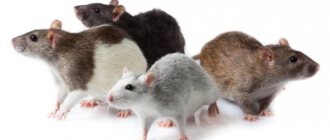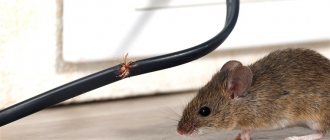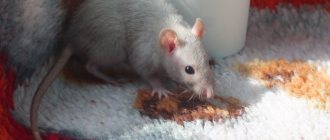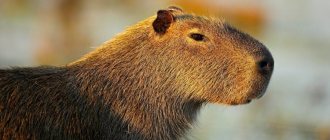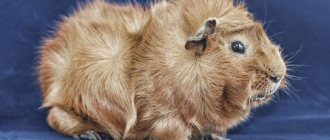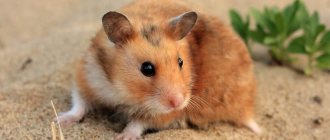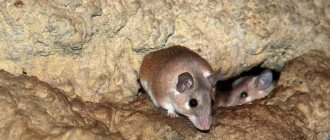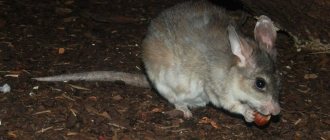The most numerous order of mammals are rodents. A total of 2,277 species have been described. They can be found almost everywhere, anywhere on our planet, with the exception of Antarctica and some islands.
Typically, all rodents are small in size, from 5 to 130 cm, but on average do not exceed 50 cm. Many of them have a particularly long tail, which is significantly larger than their body size, but some have it completely absent, such as sea pigs.
The smallest rodent is only 3 cm in length (plus 2 cm for the tail), it weighs only 7 g. Some rodents are impressive in their size. Thus, the average weight of a capybara is 65 kg, and individual specimens weigh up to 91 kg.
The largest are rodents, which have long since become extinct. The remains of giant representatives of this group were found, the largest of which weighed from 1 to 1.5 tons, it is possible that it reached a size of 2.5 tons. Nowadays it is impossible to meet such giants.
But still, the largest rodents in the world amaze with their size, despite the fact that in our society there has long been a stereotype that if it is a rodent, then it is a tiny animal that fits in the palm of your hand.
Indian giant squirrel
It is also called Indian ratufa . This is a tree squirrel that can be found in India. Prefers mixed or deciduous forests. These animals usually live in groups.
In each individual habitat they have their own fur color, so you can easily determine where this or that animal was caught. Usually the color scheme consists of 2-3 colors, from beige to brown in different shades, and yellow is also found. Indian giant squirrels have a white patch between their ears
The length of the squirrel, if you count the head and body, is 36 cm (adult), but they also have a long tail, which grows up to 61 cm. An adult squirrel weighs about 2 kg. They prefer to live in the upper layer of the forest. These are very cautious animals, they are active in the early morning and late afternoon.
Possibility of attacks on people
Whether a rat can attack a person is a pressing question. Every year, hundreds of cases of rodents attacking people and leaving bites are recorded around the world.
The risk of being bitten increases in areas where the number of rodents exceeds acceptable limits. An increase in population provokes malnutrition and hunger. This is the main reason for the aggressive behavior of rodents. Rats can attack large mammals, birds, and humans in a hopeless situation:
- if a rodent is cornered, you need to protect your life;
- aggressive behavior is associated with an unbearable feeling of hunger;
- the animal has rabies.
Before jumping on a person, the animal takes a characteristic pose. It rises on its hind legs and a grin appears on its muzzle. Attacks with a jump. It can bite on the legs, arms, and grabs small children by the neck. A rat attacks a person with particular cruelty. An extremely dangerous situation when you have to defend yourself from several rodents.
Rat bites A rabid rat bites a person with particular aggressiveness
As the disease progresses, the sense of caution disappears, and the animal mindlessly rushes to attack all living beings. Outwardly, it is distinguished from a healthy rat by the presence of saliva that pours from its mouth, redness of the eyes
Soviet chinchilla
Despite the name, we are not talking about a chinchilla at all, but about a breed of rabbits that are bred for their fur. It was bred in the USSR. Our specialists crossed American chinchillas with different breeds and were able to increase the live weight of the animal to 5 kg.
In 1963, a new breed, the Soviet chinchilla, . Its representatives are distinguished by thick fur, high-quality skin, large size, good endurance and early ripening.
Their body is 60-70 cm long, they are silver or dark silver, the belly and part of the paws are black, and there is a border of the same color on the ears. An adult rabbit weighs from 3 to 5 kg, among them there are record holders who gained up to 7-8 kg.
The biggest rat in the world
The largest rat, Bosavi, lives on the island of Papua, New Guinea. These rodents were found by scientists in the extinct Bosavi volcano.
The animals were not afraid of people, since they did not imagine that they could pose any danger to them, so they calmly allowed themselves to be measured and weighed. Their body length is approximately 1 meter and their weight is about 15 kilograms.
The rat still does not have an official name; it is temporarily named after the Bosavi volcano. In our time, this is the largest specimen.
Nutria
Its other names are swamp beaver or koipu . " Nutria " is translated from Greek as "mouse-beaver". In appearance it resembles a rat of enormous size: the body grows up to 60 cm, the tail is 45 cm, it weighs from 5 to 12 kg. Males are usually larger than females.
She has a huge head with small ears and eyes, and a blunt muzzle. The tail is hairless, it is a kind of rudder that is used when swimming. The fur of this animal is waterproof and brown.
Nutria lives in South America, but it has been able to acclimatize in many countries. It is active at night. Lives in groups of 2-13 individuals.
The largest domestic rats
Many people keep rodents in their homes, of different sizes, colors and personalities. And this is not surprising, because rodents are very easy to maintain and do not require special expenses. You can feed the animal either human food or special food from a pet store. Unfortunately, the life of a rat is short, only 2–4 years, and losing a beloved pet is never easy. The exception is not large breeds of rats, which we will consider.
Breed Standard
The most common breed among domestic rodents. They get used to people very quickly, they are friendly, they don’t bite, they like to sit on someone’s arms or shoulder. This breed is the ancestor of all decorative rats; they began to be kept at home earlier than anyone else.
Rats are very clean animals and regularly wash their fur themselves. Their cage needs to be cleaned at least once a week, and care should be taken to ensure that the water bowl is never empty. Rats need to be let out for a walk, allowed to get acquainted with the area, they cannot be in a closed space around the clock.
They grow up to 30 centimeters and weigh 300–500 grams.
Large brown rats
Another breed of large domestic rodents. There is a version that they originated from China, but today they are distributed throughout the world, except Antarctica. They are very unpretentious in their diet and love to walk in the fresh air, so they are ideal for keeping in a private home with its own yard.
Their length is up to 20 cm, and their body weight is up to 150 grams. They live up to 2–3 years.
Dumbo
Less common, different from their relatives in appearance. The ears are set lower than the others, protruding and round. Their body shape resembles a pear.
They are very affectionate, have a good memory, and are able to remember a nickname. They should be fed boiled chicken, cottage cheese, vegetables, grains and herbs.
The body size is 18–20 centimeters, and the weight is from 250 to 500 grams. Life expectancy is 2–3 years, but with proper maintenance they can live 4–5 years.
Baybak
Another name is common marmot . It lives in the virgin steppes of Eurasia. The English name “Bobak marmot” comes from the Turkic word “ baibak ”, which also means “marmot”.
It is similar to other marmots, but stands out for its yellow coloring and short tail, which does not exceed 15 cm in length. The bobak also stands out for its size: its body length is from 50 to 70 cm, a fattened male can weigh up to 10 kg.
Once upon a time it was a common animal that lived in the steppe zone from Hungary to the Irtysh. But due to the plowing of virgin lands, the amount of area it occupied was significantly reduced, because they cannot live in vegetable and grain crops. Baibaks form perennial colonies and make many burrows for themselves. They feed on plant foods.
How much does a bull terrier cost?
Puppies of this breed are very cute. If you have decided to get one, then you need to contact a good nursery. It is not recommended to purchase through an ad or on the market. Improper breeding causes the development of various genetic diseases.
The baby can be picked up at the age of two and a half months. At this age, all necessary vaccinations are given. At the time of choosing a puppy, the condition of the teeth is checked; there should be six of them on the bottom and top.
Your hearing status must be checked. This is due to the fact that bull terriers are often born deaf. To check, just clap your hands, to which the baby must respond. It is advisable to pay attention to the parents or familiarize yourself with the pedigree. This information is provided by all good nurseries.
Bull Terrier puppy
The price of a puppy depends on a variety of factors. Title and pedigree drive up the value. Therefore, the cost of a bull terrier can vary from 15,000 to 70,000 rubles. If we consider a puppy without a pedigree, then the price drops from 10,000 to 15,000 rubles. Many people associate the name of the breed with fighting matches, but this is not entirely true. Most puppies become just loyal friends.
Pacarana
Another name for it is false pack . The pacarana looks like a guinea pig, but is a fairly large rodent. Her body length is from 73 to 79 cm, she weighs 10-15 kg.
This is a massive, heavy animal. The tail is about a third of the body in size. She has a wide head, on which there are round ears and unusually large eyes.
Pacarana is black or dark brown, has white spots, and has coarse and sparse fur. You can meet her in the forests of the Amazon. These are slow animals. Not much is known about their life.
Gilts
Photo: pixabay.com
Guinea pig. The size and color of the pig depends on the breed. All over the world, pigs are kept at home as pets. Features of caring for a pig are determined by its breed. What they have in common is that pigs need to additionally introduce ascorbic acid into their diet and exclude animal food: these are herbivores.
Pigs reproduce well in captivity.
Mara
They are also called Patagonian hares or Patagonian pigs . Mara can grow up to 69-75 cm, large individuals gain weight up to 9-16 kg. Their tail is only 4.5 cm long.
The upper part of their body is grayish, the lower part is whitish, and there are white or yellow stripes on the sides. This rodent has thick fur.
You can meet mara in South America. They prefer to go out in search of food during the day, gather for communal feeding, and feed on plants.
Dormouse
Hazel Dormouse Photo: ru.wikipedia.org
Dormouse. Of the 4 Russian species, the hazel dormouse is suitable for home keeping. She is easily tamed, takes food from her hands and allows herself to be petted.
Sonya is a cute animal, similar to a squirrel, up to 9 cm long, weighing up to 27 g. Red color. Sonya spends most of her life in trees. Active from dusk until morning. The dormouse makes a nest from blades of grass, which it lines with bark and moss. Sometimes it occupies bird nests. In nature it lives for 2-3 years, in captivity - up to 6 years.
- Food: nuts, acorns, chestnuts, fruits, berries, young shoots, tree buds. Sometimes it drinks the eggs of small birds.
In winter it hibernates, moving into underground burrows. Doesn't stock up. Sonya is a loner. Dormouse should be kept in a cage with many shelves, perches and branches for climbing. In captivity, only the hazel dormouse produces offspring.
Flanders
This is the name of one of the rabbit breeds. She was bred in Belgium. Flanders is one of the most famous and widespread breeds; exactly how it was obtained is not known exactly.
These rabbits are bred in many countries, and in each of them Flanders have their own characteristics. There are German, English, Spanish, etc. representatives of this breed. They did not take root in the USSR due to the harsh climate, but were used to breed the “gray giant” breed.
Flanders amazes with its size. They have a long body - up to 67 cm, high, thick and dense fur, color - gray or yellow-gray. Adult rabbits weigh 7 kg, some of them grow up to 10-12 kg, there are record holders weighing 25 kg.
Chipmunk
The Asian chipmunk lives in Russia. Body length - up to 15 cm, gray or reddish fur with five dark stripes along the back. The tail is long and fluffy. The ears are round, without tufts. Has developed cheek pouches.
- Food: grains, plant parts, nuts, fruits, berries, fish, shellfish, insects, eggs of small birds. In captivity, it eats boiled meat, cottage cheese, bread, and dried fruits. Drinks a lot. A chipmunk will not drink dirty water. In nature it lives for 2-3 years, in captivity - up to 8 years. Makes supplies for the winter.
In captivity you need a large cage with a wheel and a house. In the house, the chipmunk makes a nest from cotton wool, rags, paper and leaves. Chipmunks are loners and do not get along well with each other. Among males, fights often end in death. Even animals of different sexes can fight.
Chipmunk Photo: pixabay.com
The domestic chipmunk eats from hands and allows itself to be petted, but will bite strongly if touched on the stomach or throat. In winter, the chipmunk sleeps, without leaving the house for days. During this period, his movements are sluggish and can be aggressive. In captivity it reproduces easily. One litter per year, 3-8 chipmunks.
You should not pull a chipmunk's tail: its skin is thin and can be easily torn off. It bites off the exposed tail, but loses maneuverability and dies.
The main feature of caring for an animal is to protect it from intestinal disorders. They very often lead to the death of a chipmunk. It does not tolerate heat and direct sunlight. Temperatures above 27 degrees can be fatal for him.
Crested porcupine
It is often called the porcupine . The thick and stocky body of the animal is covered with dark and white needles. He has 2 types. There are long and flexible ones, growing up to 40 cm, and there are short and hard ones, 15-30 cm each, but differing in significant thickness.
The crested porcupine has a rounded muzzle with round eyes. He has short legs, he moves slowly, but he can also run. He uses his voice very rarely, only in moments of danger or irritation.
This is a very large rodent, growing up to 90 cm, plus a tail of 10-15 cm. Average weight is 8-12 kg, but some well-fed males weigh up to 27 kg.
Rodents
Hamsters, nutria, ground squirrels, porcupines - all these animals are united by belonging to the order of rodents, the most numerous in the class of mammals. Today there are 2606 species of these animals. Unfortunately, 49 species have become extinct over the past 5 centuries, and some are now on the verge of extinction.
Beaver
A semi-aquatic mammal with beautiful fur, consisting of coarse hair and very thick silky underfur. It is light chestnut or dark brown in color, the tail and paws are black.
The beaver is one of the largest rodents, its body length is from 1 to 1.3 m, and its weight is from 30 to 32 kg. It was once common throughout Europe and Asia, but by the beginning of the twentieth century it was almost exterminated, but now it can be found almost everywhere. Beavers settle near rivers, lakes, and ponds, living in their huts located under water or in burrows in steep and steep banks.
Harm to a human farmer and ways to combat it
Burrowing holes, it immediately eats all the food it encounters. The ground rat destroys alfalfa most of all, and also causes significant damage to rice during the ripening period, cotton, wheat, barley, and some melons, including watermelons and melons.
also harms young trees , gnawing them underground at the root collar or seriously gnawing the bark - it especially often “gets” bird cherry, apple trees, and willow.
It eats small animals - field mice, crayfish, mollusks, insects and others (read about what voles eat in the steppe, forest, meadow here). Swims deftly and climbs trees , destroying bird nests.
It can settle in human dwellings, where it eats food and feed. It can gnaw through adobe walls and make passages under the floor .
The natural enemies of the ground rat are dogs, cats, jackals, foxes, weasels and many other predatory species, as well as birds - owls, eagles, hen harriers.
REFERENCE! Control methods are different, and they can be divided into radical, when the goal is the complete destruction of the rodent, and humane, if you need to drive the rat out of its habitat.
Initially, all methods are divided into:
- Mechanical devices - this includes all kinds of traps, traps, scarers;
- Animals - several cats in an area where earth rats live will not be able to catch the entire population, but they can scare away rodents and force them to leave their habitat;
- Chemicals - spraying of poisonous gases is used: carbon monoxide, chlorine, or substances are sprayed onto the soil, licking which the rat will die.
Radical methods - traps and poisons - are used when there is not much time to scare them away. However, it is worth keeping in mind that rats are smart animals and will not approach the mechanism if they see that someone has died in it.
In addition, radical methods can also harm other animals and plants nearby.
Humane methods involve repelling rodents:
- Ultrasonic repellers - installation of devices that generate ultrasound on the site. It happens that some rodents do not react to it, and also adapt to a constant irritant;
- Smoking - substances are placed into the burrows that produce a pungent, unpleasant odor. This could be singed wool, bunches of wormwood or mint. One interesting solution is to plant black elderberry on the plot, the roots of which release cyanide into the soil, poisonous to rats;
- Filling holes with water - earth rats are excellent swimmers, however, they will have to leave such a habitat.
IMPORTANT! There is no need to hesitate when you find an earthen rat on your property; you must choose how to get rid of it yourself, but you should not leave things to chance - the more time passes, the larger their population becomes, which means it will be more difficult to completely get rid of the rodents.
Capybara
It is also called capybara. This is a herbivorous mammal, its name consists of 8 letters ( capybara ), and is often asked in crosswords and scanwords. Its body length is 1-1.35 m, height - 50-60 cm. Males can weigh from 34 to 63 kg, females - even more, from 36 to 65.5 kg. Externally, the capybara is somewhat similar to a guinea pig; it has an elongated body and hard fur.
It can be seen in Central and South America. Lives near water, rarely goes more than 1 thousand meters from it. They are active during the day, but can also become nocturnal.
They can swim and dive, feed on aquatic plants, grass and hay, and tubers. Capybaras are calm, friendly, and are often kept as pets.
4 1

